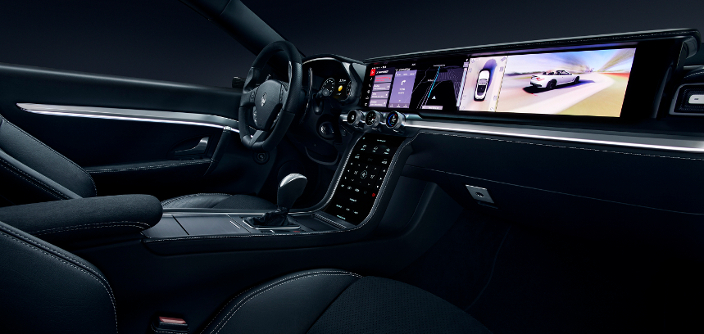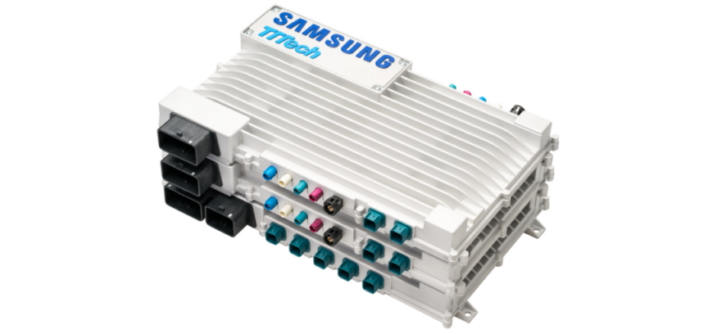“Integration is Our Secret Weapon”: Samsung and HARMAN Executives Discuss the Next Chapter for Driving
on January 11, 2018
Since Samsung acquired HARMAN in 2017, the companies have poured considerable focus and investment dollars into connected car technology to help deliver what will be the next chapter for driving and communication on the road.
Samsung Newsroom spoke with Wonsik Lee, Senior Vice President, R&D Strategy Group of Samsung Electronics’ Automotive Electronics Business, and Dr. Mike Peters, President of the Connected Car Division, HARMAN, about what to look forward to in the automotive industry, including the new Digital Cockpit platform that is being demonstrated at CES 2018.

Q. What is the purpose of the Digital Cockpit, the new automotive electronics platform that was unveiled by HARMAN and Samsung at CES 2018?
Wonsik Lee (Lee): Through our CES exhibition, Samsung is planning to introduce AI and IoT experiences to visitors, where they can easily use and control our inter-connected products and services. In order to expand Samsung’s AI and IoT platform from home appliances and mobile phones to other ‘things’ including automobiles, we developed the Digital Cockpit by infusing Samsung’s mobile, IT and display technologies with Harman’s automotive technologies. Through the Digital Cockpit showcase, we will demonstrate the new lifestyles offered by next-generation mobility, and lead innovations for the connected car business.
Since Samsung acquired Harman last March, a combined Samsung-HARMAN team has been forged to boost our competitiveness in the next-generation connected car business by seeking ways to apply Samsung’s components, products and services to automotive products. It is remarkable that we were able to jointly develop a concept for the Digital Cockpit by converging Samsung’s technologies applicable to the automotive industry with HARMAN’s technologies for the first time.
Mike Peters (Peters): With the Digital Cockpit, we wanted to bring together several previously distinct computing domains into one platform. The former infotainment system, the instrument cluster, audio and lighting controls, and connected ADAS features are brought together in a single hardware and software package. This allows the OEM to bring a much more intuitive, easy-to-use and visually-integrated approach to cockpit design.
Q. What were the insights and thinking that helped you create the Digital Cockpit?
Peters: Consumer demand is dictating that the car become an extension of the connected lifestyle rather than being a product of a siloed industry. This means in-car technology needs to replicate the smartphones and smart audio experiences people enjoy at home or the office. By integrating this into the Digital Cockpit and creating more “hands-free” tools like voice activation, haptic controls and smartphone projection, HARMAN can help OEMs meet this demand while still keeping drivers safe and focused on the road ahead.
Lee: Specifically speaking, Samsung’s mobile, IT and display product development experiences can contribute significantly to increasing the consumer value of the Digital Cockpit. As the same UX that was applied to Samsung Galaxy smartphones was incorporated into the Digital Cockpit, users can easily operate our cockpit with no learning curve. Additionally, we are going to showcase a differentiated design by merging both digital and analog aspects and applying the signature, circular design of the Samsung Gear S to the three configurable knobs. The invaluable UX experiences that Samsung has accumulated from its mobile business have been a foundation for the design of the Digital Cockpit.

Q. How will the Digital Cockpit connect with other IoT devices? How important was it to incorporate this level of connectivity from the outset?
Peters: The Digital Cockpit can connect to devices, such as a driver’s smartphone, seamlessly. In a premium configuration, it weaves together a driver’s entire connected lifestyle across the Internet of Things through a multi-display layout that leverages HARMAN’s Ignite Platform.
Lee: For example, when someone gets into their car, it recognizes them and shows a welcome message on the display monitor. The driver can then select a video from his mobile phone to be played on the car infotainment systems, or control home appliances such as their refrigerator or air conditioner through SmartThings while driving. Moreover, with Bixby, the driver can easily and safely control the car’s air conditioning, audio volume, brightness settings and more with just his voice.
Peters: This means the in-car user experience can be personalized for the driver and passenger via services such as virtual personal assistants, portable profiles, augmented reality and more. This also allows for Android to be integrated on four displays – a first for the industry. Having an agnostic platform was important to us as the collaboration between OEMs and suppliers is the only way future mobility will be successful.
Q. What are the strengths of the HARMAN-Samsung automotive electronics business?
Lee: Along with rich and diverse development experiences, Samsung owns a vast range of leading technologies in the areas of mobile, IT and components including wireless communications, UI/UX, displays and semiconductors. HARMAN, meanwhile, retains proven automotive technologies, development expertise and affluent business experiences with car makers.
Peters: Indeed, the synergies between HARMAN and Samsung have astounded me. Becoming part of Samsung has accelerated the depth and breadth of resources for innovation and synergy across all of HARMAN’s business: from the car to home and everything in between. What I admire most about our relationship with Samsung is the balance our companies offer each another. Together, we increase innovation through scale, resources and competencies, leveraging Samsung’s global scale, R&D and distribution channels, and HARMAN’s deep heritage in automotive technology.
Integration is our secret weapon, and an open ecosystem encourages collaboration to accelerate innovation and bridge ecosystems. At CES this year, we’re showing that while the in-car experience is fueled by technology, it’s ultimately human at heart. With this mantra driving our mission, we’re becoming the leader in connectivity and autonomous driving.
Q. What are the challenges you need to overcome?
Lee: Automotive electronics is relatively new to Samsung compared with other sectors that we have been focusing on, leaving a lot of room for us to grow. Especially, since it is critical that the automobile and auto components industries meet the safety standards and comply with a wide variety of different regulations in different countries, close cooperation between car makers and suppliers is essential.
Peters: The automotive technology market is also a crowded one, and with the excitement of autonomy on the horizon, there’s even more clutter to cut through. We’re no longer just in competition with other automotive suppliers, but are part of a future of mobility revolution, along with suppliers, OEMs, tech companies and even rideshare startups fighting for a piece of the pie. In order to drive innovation and lead the pack, we’re forging partnerships and harnessing our best technologies and global scale to better serve the needs of automakers in this rapidly-evolving automotive market.

Q. How do you foresee the future of connected cars combined with 5G technology, AI and autonomous vehicles?
Lee: It is expected that cars will become more than just a means of transportation in the future. Cars will gradually evolve to be our living and working space. If lesser burden is put on drivers with the advent of autonomous driving technology, users will be able to enjoy more value while on the go.
Peters: That’s true. Autonomous vehicles will create a paradigm shift in how people operate cars and many drivers will transition into passengers. 5G technology and AI will play a pivotal role in this evolution to ensure autonomous vehicles have the situational awareness needed to navigate a wide variety of environments safely. This is why HARMAN is building the industry’s first automotive-grade, 5G-ready connectivity solution that automakers can use to start building telematics solutions that will handle today’s requirements, but also be flexible in the future when 5G becomes more ubiquitous.
Lee: Connected car technology is moving beyond simply converging automobiles with IT. Cars will become a part of IoT, and be connected to all infrastructure including houses and offices. Therefore, connected cars will help us not only control appliances inside the home but also enhance road safety by data transmission among cars on the roads, and will eventually lead us to develop intelligent transportation systems that could minimize traffic congestion. With the implementation of self-driving technologies, people won’t have to drive and thus they will come to enjoy the car as a living and working space, which is essentially the ultimate goal of connected cars. This means that drivers can relax, enjoy movies, search the internet or write an email inside the moving car. This will bring about fundamental changes in our life. Furthermore, this will create new business opportunities such as real-time navigation services based on traffic data in the IT service industry, location-based services in the content industry and insurance premium discounts based on driving behavior in the insurance industry, among others.
Q. How do Samsung and HARMAN plan to lead the future automotive electronics industry?
Peters: Our collective mission is to become the architects of experience and the leaders in connectivity and autonomous driving: connecting the lives of people, whether at home, on the go or together in the car. HARMAN plays the role of expert in the automotive field while Samsung’s global scale, R&D capabilities, dominance in mobile/TV/semiconductors and distribution channels will help accelerate innovation and drive fast growth. Through the HARMAN-Samsung relationship, we can now provide a true chip-to-cloud, fully-integrated offering.
Lee: Samsung and HARMAN will continue to cooperate closely and through our close collaboration, we will reinforce our position in the connected car industry and drive innovation across the business.




